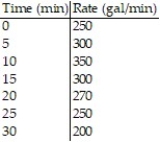A) ![]() ln
ln ![]()
B) ![]() ln
ln ![]()
C) ![]() ln
ln ![]()
D) ![]() ln
ln ![]()
F) None of the above
Correct Answer

verified
Correct Answer
verified
Multiple Choice
Give the appropriate form of the partial fraction decomposition.
-
A) ![]() +
+ ![]()
B) ![]() +
+ ![]()
C) ![]() +
+ ![]()
D) ![]() +
+ ![]()
F) All of the above
Correct Answer

verified
Correct Answer
verified
Multiple Choice
Evaluate the integral.
-  cos 8 d
cos 8 d
A) ![]()
B) ![]()
C) ![]()
D) ![]()
F) A) and D)
Correct Answer

verified
Correct Answer
verified
Multiple Choice
Solve the problem.
-Consider the region R bounded by the graph of f(x) = ![Solve the problem. -Consider the region R bounded by the graph of f(x) = on the interval [0, 3]. Find the volume of the solid formed when R is revolved about the y-axis. A) \pi B) 2 \pi C) \pi D) 2 \pi](https://d2lvgg3v3hfg70.cloudfront.net/TB9662/11ee9522_343e_2a71_bdb6_af822298222e_TB9662_11.jpg) on the interval [0, 3]. Find the volume of the solid formed when R is revolved about the y-axis.
on the interval [0, 3]. Find the volume of the solid formed when R is revolved about the y-axis.
A) ![]()
B) 2 ![]()
C) ![]()
D) 2 ![]()
F) B) and C)
Correct Answer

verified
Correct Answer
verified
Multiple Choice
Evaluate the integral by making a substitution and then using a table of integrals.
-
A) ![]()
![]()
![]() + C
+ C
B) ![]()
![]()
![]() + C
+ C
C) ![]()
![]()
![]() + C
+ C
D) ![]()
![]()
![]() + C
+ C
F) B) and C)
Correct Answer

verified
Correct Answer
verified
Multiple Choice
Solve the problem.
-Find the volume of the solid obtained by revolving the region bounded by the curve y =  on
on  about the y-axis. Round to 3 decimal places.
about the y-axis. Round to 3 decimal places.
A) ![]() 8.268
8.268
B) ![]() 13.497
13.497
C) ![]() 12.021
12.021
D) ![]() 7.718
7.718
F) A) and C)
Correct Answer

verified
Correct Answer
verified
Multiple Choice
Solve the problem.
-The following table shows the rate of water flow (in gal/min) from a stream into a pond during a 30-minute period after a thunderstorm. Use Simpson's Rule to estimate the total amount of water flowing into the pond during this period. Round your answer to the nearest gallon.

A) 9725 gal
B) 8475 gal
C) 7717 gal
D) 8483 gal
F) A) and C)
Correct Answer

verified
Correct Answer
verified
Multiple Choice
Express the integrand as a sum of partial fractions and evaluate the integral.
-
A) ![]() +
+ ![]() ln
ln ![]() + C
+ C
B) ![]() +
+ ![]() ln
ln ![]() + C
+ C
C) ![]() +
+ ![]() ln
ln ![]() + C
+ C
D) ![]() +
+ ![]() ln
ln ![]() + C
+ C
F) A) and C)
Correct Answer

verified
Correct Answer
verified
Multiple Choice
Integrate the function.
- , x > 7
, x > 7
A) ln ![]() + C
+ C
B) ![]() + C
+ C
C) ln ![]() + C
+ C
D) ![]() + C
+ C
F) C) and D)
Correct Answer

verified
Correct Answer
verified
Multiple Choice
Use Simpson's Rule with n = 4 steps to estimate the integral.
-
A) ![]()
B) ![]()
C) ![]()
D) ![]()
F) A) and C)
Correct Answer

verified
Correct Answer
verified
Multiple Choice
Express the integrand as a sum of partial fractions and evaluate the integral.
- dx
dx
A) ln ![]() + C
+ C
B) ln ![]() + C
+ C
C) ln ![]() + C
+ C
D) ln ![]() + C
+ C
F) A) and C)
Correct Answer

verified
Correct Answer
verified
Multiple Choice
Use reduction formulas to evaluate the integral.
-
A) ![]()
B) ![]()
C) ![]()
D) ![]()
F) A) and D)
Correct Answer

verified
Correct Answer
verified
Multiple Choice
Evaluate the improper integral.
-
A) -16
B) 4
C) 16
D) -4
F) B) and D)
Correct Answer

verified
Correct Answer
verified
Multiple Choice
Evaluate the integral.
-
A) ![]()
B) ![]()
C) ![]()
D) ![]()
F) A) and D)
Correct Answer

verified
Correct Answer
verified
Multiple Choice
Use integration by parts to establish a reduction formula for the integral.
-
A) ![]()
B) ![]()
C) ![]()
D) ![]()
F) All of the above
Correct Answer

verified
Correct Answer
verified
Multiple Choice
Use Simpson's Rule with n = 4 steps to estimate the integral.
-
A) ![]()
B) ![]()
C) ![]()
D) ![]()
F) A) and B)
Correct Answer

verified
Correct Answer
verified
Multiple Choice
Evaluate the integral.
-
A) 2 ![]() + C
+ C
B) 2 ![]() + C
+ C
C) 2 ![]() + C
+ C
D) 2 ![]() + C
+ C
F) B) and D)
Correct Answer

verified
Correct Answer
verified
Multiple Choice
Express the integrand as a sum of partial fractions and evaluate the integral.
-  dx
dx
A) ![]()
B) ![]()
C) ![]()
D) ![]()
F) A) and D)
Correct Answer

verified
Correct Answer
verified
Multiple Choice
Find the volume.
-Find the volume of the solid generated by revolving the region under the curve  from
from  to
to  about the
about the 
A) 9
B) ![]()
C) 18
D) 9
F) A) and C)
Correct Answer

verified
Correct Answer
verified
Multiple Choice
Evaluate the integral.
- Give your answer in exact form.
Give your answer in exact form.
A) ![]()
B) ![]()
C) ![]()
D) ![]()
F) A) and C)
Correct Answer

verified
Correct Answer
verified
Showing 121 - 140 of 287
Related Exams